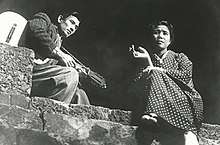A Japanese Tragedy
A Japanese Tragedy (日本の悲劇, Nihon no higeki), also known as Tragedy of Japan, is a Japanese film directed by Keisuke Kinoshita and released in 1953. Kinoshita interspersed newsreel footage within the film in an attempt to relate the story of the film to the wider context of Japan's post-war difficulties.[1] The film tells the story of a mother, played by Yūko Mochizuki, who had to raise two children during and after World War II but whose children reject her.[2][3]
| A Japanese Tragedy | |
|---|---|
 Still photo of A Japanese Tragedy (Nihon no Higeki), 1953 | |
| Japanese | 日本の悲劇 |
| Directed by | Keisuke Kinoshita |
| Written by | Keisuke Kinoshota |
| Cinematography | Hiroshi Kusuda |
Production company | |
Release date |
|
| Country | Japan |
| Language | Japanese |
The film incorporates flashbacks to provide context for the family's present day misunderstandings. For example, the mother, Haruko, gets involved in the black market to provide food for the family, but her son Seiichi only knows that the activity causes him embarrassment at school.[4] The mother leaves the children with their uncle so that she can raise money working as a prostitute, but the uncle treats them cruelly and tells them that their mother is enjoying herself at the Atami hot springs.[4] The flashbacks also show how Haruko was abused by her male clients and was only able to keep going by reminding herself that she needed to do this for her children.[4] The flashbacks also show that the daughter was raped by her cousin.[4]
Alexander Jacoby regarded the basic story of the mother and her selfish children to be more "vivid" than the wider context provided by the newsreels.[1] Isolde Standish points out that the newsreels give credence to the "subjective memories" of the characters that are shown in the film's flashback scenes.[4] For example, newsreel footage of American soldiers cavorting with Japanese women foreshadow a flashback scene depicting Haruko's decision to become a prostitute.[4]
According to film critic Donald Richie, A Japanese Tragedy was one of the first post-war films to focus on Japanese mothers, as Mikio Naruse's Repast was one of the first to focus on the plight of Japanese wives.[2]
Kinoshita won both the Mainichi Film Award and Blue Ribbon Award for best screenplay in 1954.[5] Mochizuki won the 1954 Mainichi Film Award for best actress.[5]
Cast
- Yūko Mochizuki - Haruko Inoue
- Yōko Katsuragi - Haruko's daughter
- Masumi Taura - Haruko's son
- Teiji Takahashi - Sato
- Keiji Sada - Tatsuya, street musician
- Ken Uehara - Masayuki Akazawa, the English teacher
- Sanae Takasugi - Mrs. Akazawa
- Keiko Awaji - Wakamaru, a geisha
References
- Jacoby, A. (2008). A Critical Handbook of Japanese Film Directors. Stone Bridge Press. ISBN 9781933330532.
- Richie, D. (2012). A Hundred Years of Japanese Film. Kodansha. pp. 117, 276. ISBN 9781568364391.
- "A Japanese Tragedy". Strictly Film School. Retrieved 2018-11-24.
- Standish, I. (2006). A New History of Japanese Cinema. Bloomsbury Publishing. pp. 204–208. ISBN 9781441161543.
- "A Japanese Tragedy awards". IMDb. Retrieved 2014-09-25.